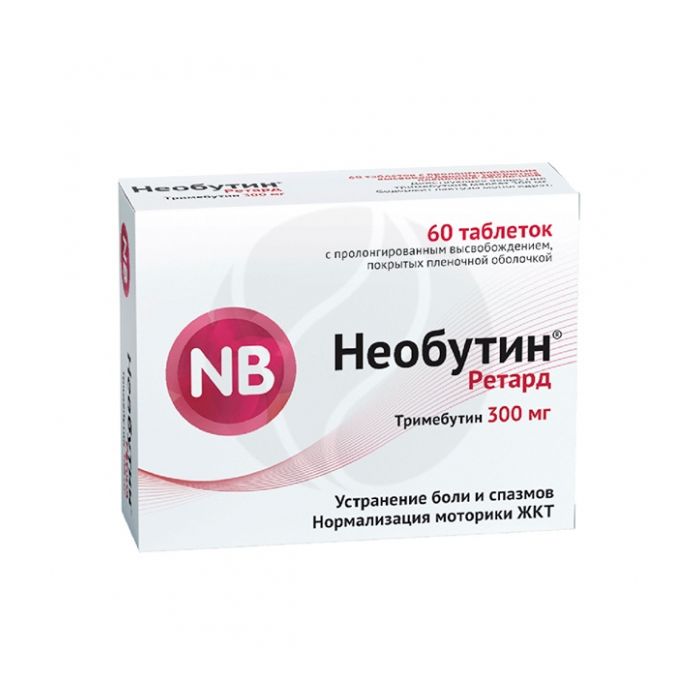Neobutin retard tablets 300mg, No. 60
Expiration Date: 11/2025
Russian Pharmacy name:
Необутин ретард таблетки 300мг, №60
Symptomatic treatment of abdominal pain and discomfort, cramps, bloating (flatulence), intestinal motor disorders with changes in stool frequency (diarrhea, constipation or their alternation), changes in stool consistency associated with irritable bowel syndrome.
Postoperative paralytic intestinal obstruction.
The drug is taken orally.
Adults and children over 12 years old are prescribed 1 tab. 2 times / day (with a break of 12 hours).
To prevent recurrence of irritable bowel syndrome after the course of treatment during the period of remission, it is recommended to continue taking the drug at a dose of 300 mg / day for 12 weeks.
for 1 tablet:
active substance: trimebutine maleate 300.0 mg;
Excipients:
Tablet core: lactose monohydrate 180.0 mg, tartaric acid 120.0 mg, hypromellose 120.0 mg, povidone KZ012.0 mg, colloidal silicon dioxide 7.5 mg, magnesium stearate 7.5 mg.
Sheath: hypromellose 6.82 mg, talc 1.35 mg, Opasprey white M-1-7111 [titanium dioxide 30.0%, denatured ethanol (methylated alcohol) 10.0%, hypromellose-2910 3.0%, water 57 , 0%] 2.25 mg, silicon antifoam qs
Hypersensitivity to the components that make up the drug.
Children under 12 years of age.
Pregnancy.
Lactose intolerance, lactase deficiency, glucose-galactose malabsorption.
Carefully
Trimebutin should be used with caution during breastfeeding, because there is no data on its ability to pass into breast milk.
Trade name of the drug:
NEOBUTINЃ retard
International non-proprietary name:
Trimebutin
Dosage form:
prolonged-release film-coated tablets
Composition:
for 1 tablet:
active substance: trimebutine maleate 300.0 mg;
Excipients:
Tablet core: lactose monohydrate 180.0 mg, tartaric acid 120.0 mg, hypromellose 120.0 mg, povidone KZ012.0 mg, colloidal silicon dioxide 7.5 mg, magnesium stearate 7.5 mg.
Sheath: hypromellose 6.82 mg, talc 1.35 mg, Opasprey white M-1-7111 [titanium dioxide 30.0%, denatured ethanol (methylated alcohol) 10.0%, hypromellose-2910 3.0%, water 57 , 0%] 2.25 mg, silicon antifoam qs
Description:
Film-coated tablets of white or almost white color, biconvex, oblong in shape with rounded ends. In cross section, the core is white or almost white. During the production of Samil Pharm. Co., LTD ', Republic of Korea' SR 'marking is additionally applied on one side of the tablet by the embossing method.
Pharmacotherapeutic group:
antispasmodic agent.
Pharmacological properties
Pharmacodynamics
Trimebutin, acting on the enkephalinergic system of the intestine, is a regulator of its peristalsis. Acting on peripheral? -,? - and k- receptors, including those located directly on smooth muscles throughout the gastrointestinal tract (GIT), it regulates motility without affecting the central nervous system. Thus, trimebutin restores the normal physiological activity of the intestinal musculature in various diseases of the gastrointestinal tract associated with motility disorders. By normalizing visceral sensitivity, trimebutin provides an analgesic effect in abdominal pain syndrome.
Pharmacokinetics
Absorption and distribution.
After oral administration, trimebutin is rapidly absorbed from the gastrointestinal tract. The volume of distribution (Vd) is 88 liters. The degree of binding to blood plasma proteins is low - about 5%. Trimebutin slightly crosses the placental barrier.
Metabolism and excretion.
Trimebutin is biotransformed in the liver and excreted in the urine mainly in the form of metabolites.
Indications for use
Symptomatic treatment of abdominal pain and discomfort, cramps, bloating (flatulence), intestinal motor disorders with changes in stool frequency (diarrhea, constipation or their alternation), changes in stool consistency associated with irritable bowel syndrome.
Postoperative paralytic intestinal obstruction.
Contraindications
Hypersensitivity to the components that make up the drug.
Children under 12 years of age.
Pregnancy.
Lactose intolerance, lactase deficiency, glucose-galactose malabsorption.
Application during pregnancy and during breastfeeding
Pregnancy. Experimental studies have not revealed data on teratogenicity and embryotoxicity of trimebutin. However, due to the lack of necessary clinical data, the use of trimebutin during pregnancy is contraindicated.
Breastfeeding period. It is not recommended to use trimebutine during breastfeeding, due to the lack of reliable clinical data confirming the safety of using trimebutin during this period.
If necessary, the use of trimebutine during breastfeeding, breastfeeding should be discontinued.
Method of administration and dosage
Inside, before meals.
Adults and children over 12 years old, 300 mg 2 times a day.
The maximum daily dose is 600 mg.
Side effect
From the digestive system: dry mouth, unpleasant taste, diarrhea, dyspepsia, epigastric pain, nausea, constipation.
From the nervous system: drowsiness, fatigue, dizziness, headache, anxiety, weakness, feeling of heat or cold.
Allergic reactions: allergic skin reactions. Others: menstrual irregularities, painful enlargement of the mammary glands, urinary retention.
Overdose
To date, no cases of trimebutine overdose have been reported.
Interaction with other medicinal products
Interaction of the drug NeobutinЃ retard has not been described.
special instructions
The recommended course of treatment for irritable bowel syndrome in the acute period is 600 mg per day for 4 weeks.
Influence on the ability to drive vehicles and mechanisms
NeobutinЃ retard does not have a sedative effect, does not affect the speed of psychomotor reaction and can be used in people of various professions, including those requiring increased attention and coordination of movements. However, given the possible side effects that can affect these abilities (dizziness and others), care should be taken when driving vehicles and engaging in other potentially hazardous activities.
Release form
Sustained-release film-coated tablets, 300 mg.
5.10 tablets in a blister strip made of polyvinyl chloride film and lacquered aluminum foil.
1, 2, 3, 4 or 6 blisters, together with instructions for use, are placed in a cardboard box.
Storage conditions
In a dark place at a temperature not exceeding 25 ? C.
Keep out of the reach of children.
Shelf life
3 years.
Do not use after the expiration date printed on the package.
Vacation conditions
Without recipe.

